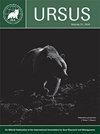社交网络分析揭示大熊猫隐藏的社交复杂性
IF 0.8
4区 生物学
Q4 ZOOLOGY
引用次数: 0
摘要
摘要:对动物社会网络的分析传统上是针对那些表现出社会行为(如群体生活)的物种进行的,而对那些被认为是独居的、神秘的、通过气味标记线索进行交流的物种的研究相对较少。我们在2015年3月至2016年2月期间进行了非侵入性粪便基因采样,在中国西南部的一个研究种群中鉴定了大熊猫(Ailuropoda melanoleuca)的个体。然后,我们使用时空接近阈值来推断基于气味标记的关联网络,并对种群进行社会网络分析。结果表明,在社会集群中,集群成员优先相互关联。遗传亲缘关系在交配季节之外是一个积极的预测因素,但在交配季节(Mar-Jun)是一个消极的预测因素,潜在地表明一种行为改变会降低近亲繁殖和近亲竞争的风险,我们称之为“亲属空间识别”。我们的研究结果表明,在通常被认为是孤立的物种中,个体之间的联系可能是广泛存在的,并且依赖于复杂的行为。本文章由计算机程序翻译,如有差异,请以英文原文为准。
Social network analysis uncovers hidden social complexity in giant pandas
Abstract: Analyses of animal social networks have traditionally been conducted on species that exhibit social behaviors such as group living, whereas relatively less work has been done on species that are thought of as solitary, are cryptic, and that communicate through scent-marking cues. We employed noninvasive fecal genetic sampling, conducted from March 2015 to February 2016, to identify individuals of one such species, the giant panda (Ailuropoda melanoleuca), across a study population in southwestern China. We then used spatiotemporal proximity thresholds to infer scent mark–based association networks and conduct social network analyses of the population. Results show social clustering in which cluster members preferentially associated with each other. Genetic relatedness was a positive predictor of associations outside the mating season but a negative predictor of associations in the mating season (Mar–Jun), potentially indicating a behavioral change that would reduce risk of inbreeding and kin competition that we term “kin-space recognition.” Our findings suggest that associations between individuals in species generally thought of as solitary may be widespread and dependent on complex behavior.
求助全文
通过发布文献求助,成功后即可免费获取论文全文。
去求助
来源期刊

Ursus
生物-动物学
CiteScore
2.00
自引率
15.40%
发文量
12
审稿时长
>12 weeks
期刊介绍:
Ursus includes a variety of articles on all aspects of bear management and research worldwide. Original manuscripts are welcome. In addition to manuscripts reporting original research, submissions may be based on thoughtful review and synthesis of previously-reported information, innovative philosophies and opinions, and public policy or legal aspects of wildlife conservation. Notes of general interest are also welcome. Invited manuscripts will be clearly identified, but will still be subject to peer review. All manuscripts must be in English. All manuscripts are peer-reviewed, and subject to rigorous editorial standards.
 求助内容:
求助内容: 应助结果提醒方式:
应助结果提醒方式:


